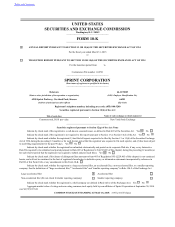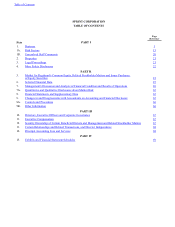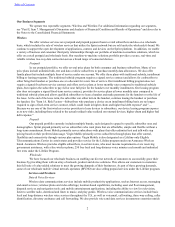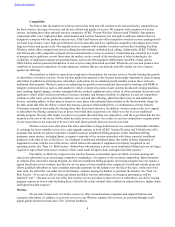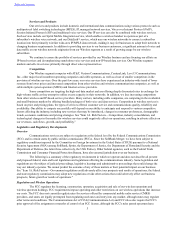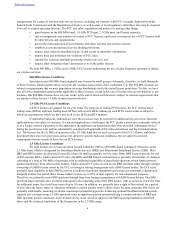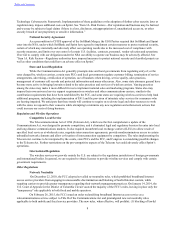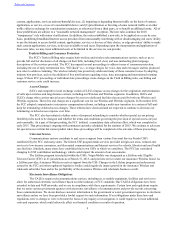Sprint - Nextel 2014 Annual Report Download - page 9
Download and view the complete annual report
Please find page 9 of the 2014 Sprint - Nextel annual report below. You can navigate through the pages in the report by either clicking on the pages listed below, or by using the keyword search tool below to find specific information within the annual report.
Table of Contents
7
Spectrum Reconfiguration Obligations
In 2004, the FCC adopted a Report and Order that included new rules regarding interference in the 800 MHz band
and a comprehensive plan to reconfigure the 800 MHz band (the "Report and Order"). The Report and Order provides for the
exchange of a portion of our 800 MHz FCC spectrum licenses, and requires us to fund the cost incurred by public safety
systems and other incumbent licensees to reconfigure the 800 MHz spectrum band. Also, in exchange, we received licenses for
10 MHz of nationwide spectrum in the 1.9 GHz band.
The minimum cash obligation under the Report and Order is $2.8 billion. We are, however, obligated to pay the full
amount of the costs relating to the reconfiguration plan, even if those costs exceed $2.8 billion. As required under the terms of
the Report and Order, a letter of credit has been secured to provide assurance that funds will be available to pay the relocation
costs of the incumbent users of the 800 MHz spectrum. The letter of credit was initially required to be $2.5 billion, but has
been reduced during the course of the proceeding to $406 million as of March 31, 2015. Total payments directly attributable to
our performance under the Report and Order, from the inception of the program through March 31, 2015, were approximately
$3.4 billion. Payments incurred during the year ended March 31, 2015 primarily related to FCC licenses. When incurred,
substantially all costs are accounted for as additions to FCC licenses with the remainder as property, plant and equipment.
Although costs incurred through March 31, 2015 have exceeded $2.8 billion, not all of those costs have been reviewed and
accepted as eligible by the transition administrator.
Completion of the 800 MHz band reconfiguration was initially required by June 26, 2008 and public safety
reconfiguration is nearly complete across the country with the exception of Washington State and the four states that share a
common border with Mexico. The FCC continues to grant the remaining 800 MHz public safety licensees additional time to
complete their band reconfigurations which, in turn, delays our access to our 800 MHz replacement channels in these areas. In
the areas where band reconfiguration is complete Sprint has received its replacement spectrum in the 800 MHz band and is
deploying 3G CDMA and 4G LTE on this spectrum in combination with its spectrum in the 1.9 GHz and 2.5 GHz bands.
New Spectrum Opportunities and Spectrum Auctions
Several FCC proceedings and initiatives are underway that may affect the availability of spectrum used or useful in
the provision of commercial wireless services, which may allow new competitors to enter the wireless market. While in
general we cannot predict when or whether the FCC will conduct any spectrum auctions or if it will release additional
spectrum that might be useful to wireless carriers, including us, in the future, the FCC has taken steps to license spectrum
designated for auction in the Middle Class Tax Relief and Job Creation Act of 2012. In particular, the FCC has initiated three
proceedings to auction the advanced wireless services H Block, advanced wireless services in the 1.7 and 2 GHz bands
(AWS-3), and to reallocate and auction broadcast spectrum in the 600 MHz Band. We did not participate in the H Block and
AWS-3 auctions.
The FCC intends to commence the 600 MHz Broadcast Incentive auction in early 2016. For the 600 MHz Incentive
Auction, the FCC has adopted rules that include “reserved” channels whereby, if certain auction conditions are met, Sprint
would be eligible to bid for the reserved channels while carriers that exceed a certain threshold of low band spectrum holdings
would not. Sprint would also be able to bid on the “unreserved” channels. Sprint evaluates all opportunities to acquire
additional spectrum; however, it is premature to make any firm participation decisions at this time as the FCC is still
considering the applicable auction processes and procedures.
911 Services
Pursuant to FCC rules, CMRS providers, including us, are required to provide enhanced 911 (E911) services
including, depending upon the capabilities of the requesting public safety answering point (PSAP), the location of the cell site
from which the call is being made or the location of the subscriber's handset using latitude and longitude. CMRS providers are
also now required to provide text-to-911 services upon request by a capable PSAP. The FCC recently revised the location
accuracy standards for the provision of wireless 911 services indoors and these requirements may impose additional
obligations.
Cyber Security
Cyber security continues to receive attention at the federal, state and local levels. Congress is considering
cybersecurity legislation to increase the security and resiliency of the nation's digital infrastructure. In addition, over the past
few years the President has issued executive orders directing the Department of Homeland Security and other government
agencies to take a number of steps to improve the security of the nation's critical infrastructure. Additionally, the
Communications Security, Reliability and Interoperability Council approved Cybersecurity Risk Management and Best
Practices, a report providing the communication industry guidance in using the National Institute of Standards and

